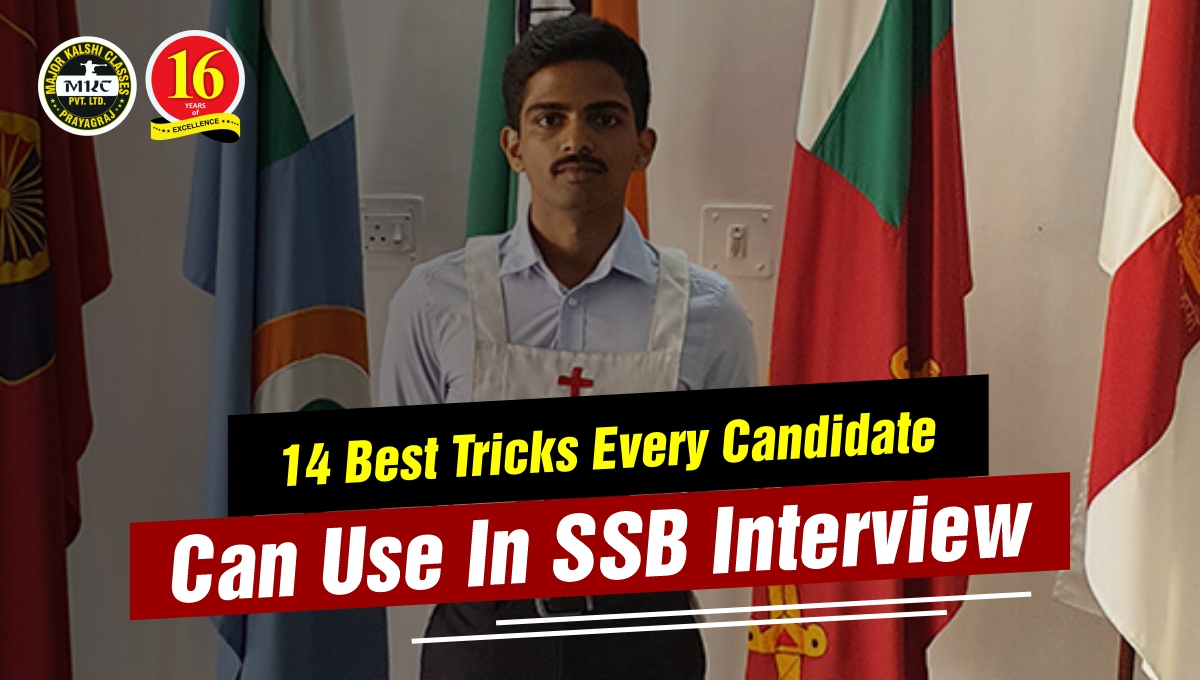14 Best Tricks Every Candidate Can Use in SSB Interview
Are you a Repeater in SSB Interview ? Do you feel low in front of your freshers in SSB ? Being a repeater in an SSB (Services Selection Board) group demands considerable courage, especially if it’s your initial attempts. You might find it tough to express your thoughts, share ideas, and even feel overshadowed by others, which can lead you to feel marginalized and reticent. However, this changes when you’re equipped with techniques to wield influence within the group. Apply these SSB Tricks and ensure your chances to qualify SSB. Here, we present you with effective psychological strategies that you can use during the selection process to establish your presence:
Best Psychological Tricks for SSB Interview :-

- Always stick with your words:
In group discussions or group planning exercises, it’s often a struggle to get a chance to speak. People might not readily grant you that opportunity. In such situations, a smart tactic is to keep speaking confidently without any breaks until you capture everyone’s attention. This is your chance to deliver crucial points to the group. Consider it a success!
2. Speak and Step Back:
Employ this technique to convey your ideas during group discussions (GD) and group planning exercises (GPE). Identify moments when the group is relatively quiet, swiftly share your points, and then withdraw before anyone interrupts. Repeat this process around 4 to 5 times within a task. This proves to be an effective strategy, especially when participating in GDs with fellow repeaters.
- Mutual Support:
During outdoor activities, make an effort to reciprocate and acknowledge the suggestions presented by others in the group. This demonstrates your willingness to cooperate and collaborate as a team player. Conversely, avoid being solely focused on your own efforts and disregarding input from others.
- Agree and Suggest:
In scenarios like group discussions (GD), group planning exercises (GPE), or outdoor tasks, if you notice a candidate dominating the conversation and being assertive, consider agreeing with their points. Then, smoothly interject by acknowledging the strength of their ideas while introducing your own alternative approach to execute the task. This strategy maintains harmony and allows you to contribute effectively.
- Story with Statistics:
While presenting data, remember that although statistics are accurate, people often resonate more with narratives. Begin by sharing a relevant story and subtly weave in your data within the narrative. This approach captures attention effectively.
- Maintain Composure in Arguments:
In situations where differing opinions lead to debates, like in GDs or GPEs, remain notably composed during the argument. This might cause the other person to react irrationally, providing you an opportunity to leverage their responses against them. Implement this strategy during group tasks and discussions.Follow these SSB Tricks.
- Employ Visuals:
When you notice that the situation is becoming chaotic, use figures as visual aids in your group to restore order. These figures should be close to realistic even if not exact. However, ensure that you don’t exaggerate.
- Nomination Strategy:
In Group Planning Exercises (GPE), remember these key rules: either nominate yourself for the final plan or refrain from nominating anyone. Also, avoid contradicting the group story once it’s established. When the GTO confirms the group story, respond with a simple “yes, sir.” Contradicting it now will only work against you. Follow these SSB Tricks.
- Grasp the Principle of Effort and Fulcrum:
Outdoor tests are centered around the cantilever principle. Your focus should be on identifying two key aspects: the point that restricts material motion (effort) and the point where the weight of your material is located (fulcrum). In these tasks, you have the option to either create effort, fulcrum, or both. Always strive to identify the fulcrum and effort elements in every obstacle.
- BRIEF Approach for Lecturette:
When tackling a Lecturette, follow a structured framework. For any topic you select, remember the acronym BRIEF, which stands for Background (provide context), Reason (explain why you chose the topic), Introduction (begin discussing the topic), End (conclude your discussion), and Follow-up/Conclusion (wrap up your points). Allocate around 30 seconds for each letter in the acronym, and you’ll effectively present your content within 3 minutes.Follow these SSB Tricks.
11. Give complete actions in SRT:
While writing SRT responses, follow this pattern to show a complete response:
“He did this, did this, did this and achieved this.” Follow this pattern for every response depending on the number of actions performed by the characters.
12. Format for WAT:
Just like SRT, there is a format to attempt WAT words too. While making a sentence, try to keep it in this framework: “I strongly believe that _________________”. For eg, the word “Blood” is given. One possible response could be: “I strongly believe that… blood donation is a noble cause” Just remove the prefix “I strongly believe that” before writing down your response.
- Interviewer as Your Buddy :
While in the interview, consider the interviewer as a close friend or a familiar relative. This mindset helps you engage more openly and boost your confidence. Nonetheless, remember that the interviewer’s role remains the same, so ensure your responses are well-considered and thoughtful. Follow these SSB Tricks.
Must Read : Personal Interview Tips for Freshers .
- Enhance Improvable Qualities:
When asked about qualities you’d like to improve, don’t directly state your shortcomings. Instead, mention qualities that are trainable and can be developed. For instance, you could express a desire to enhance your stamina and physical fitness, or strive to enhance your communication skills by expanding your vocabulary. These qualities are feasible to develop through practice and effort.
Do’s & Don’ts of SSB Interview :-
Here are some do’s and don’ts to keep in mind during an SSB (Services Selection Board) interview:
Do’s:
- Be Honest: Always provide truthful and authentic responses. Honesty is highly valued in the selection process.
- Be Punctual: Arrive on time for all sessions and activities. Punctuality reflects your discipline and respect for the process.
- Stay Positive: Maintain an optimistic attitude throughout. Positive individuals are perceived as better team players and leaders.
- Listen Attentively: Pay close attention to instructions and questions. Active listening demonstrates your attentiveness and comprehension.
- Speak Clearly: Communicate your thoughts clearly and confidently. Clarity in speech showcases your communication skills.
- Participate Actively: Engage actively in group discussions and tasks. Contribution demonstrates your teamwork and leadership abilities.
- Stay Calm Under Pressure: Maintain composure, especially during stressful situations. This highlights your ability to handle pressure.
- Be Respectful: Show respect to fellow candidates, assessors, and staff members. Respect is a crucial aspect of teamwork.
- Show Initiative: Volunteer for tasks and take the lead when appropriate. This displays your willingness to take on responsibilities.
- Practice Time Management: Manage your time efficiently during tasks. This reflects your organizational skills.
Don’ts:
- Don’t Exaggerate: Avoid exaggerating achievements, skills, or experiences. Stick to the truth.
- Don’t Interrupt: Refrain from interrupting others during group discussions. Listen before responding.
- Don’t Criticize Others: Avoid negative comments or criticism about fellow candidates. Focus on constructive interactions.
- Don’t Be Overconfident: Confidence is important, but avoid coming across as arrogant or overconfident.
- Don’t Show Nervousness: While nervousness is natural, try not to let it hinder your responses or body language.
- Don’t Speak Without Thinking: Take a moment to gather your thoughts before responding. Avoid impulsive answers.
- Don’t Argue Aggressively: If there’s a disagreement, maintain a respectful and calm tone. Avoid aggressive arguments.
- Don’t Overcomplicate: Express your ideas clearly without using overly complex language. Simplicity in communication is effective.
- Don’t Dominate: While participation is important, avoid monopolizing discussions. Allow others to contribute as well.
- Don’t Fear Failure: Don’t be afraid of making mistakes. Learn from them and adapt for future tasks.








